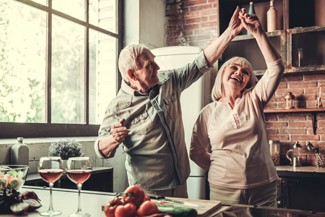Why is dancing good for the brain?
 As dictated by the eternal David Bowie, “Let’s Dance." And he’s right to encourage us to practice this art that’s not only good for the body… but also for the brain. Indeed, a recent study carried out by a German team of scientists has recently shown the benefits of dance on mental health, particularly in the elderly. And you don’t have to be a terrific dancer to enjoy the benefits! Why is dancing so good for our brains?
As dictated by the eternal David Bowie, “Let’s Dance." And he’s right to encourage us to practice this art that’s not only good for the body… but also for the brain. Indeed, a recent study carried out by a German team of scientists has recently shown the benefits of dance on mental health, particularly in the elderly. And you don’t have to be a terrific dancer to enjoy the benefits! Why is dancing so good for our brains? For their longitudinal study published in Frontiers in Human Neuroscience, the scientists examined the effects of regular dance practice on brain structure and function along with motor and cognitive performance and compared them with the effects of a fitness program. 52 healthy participants were divided into two groups: dancers and sportsmen. The training lasted 18 months during which the researchers were able to collect 26 complete data sets from 14 dancers and 12 sportsmen. The two groups did not differ in age (M= 67.9 years), sex (50% men in the dance group and 58% in the sportsmen group), education, or BMI (Body Mass Index). During the first six months, each group had two classes or trainings per week that lasted 90 minutes each. For organizational reasons, the frequency of the sessions was reduced to once a week for the last twelve months.
The dance classes aimed to induce a permanent learning situation with constantly changing choreographies that had to be memorized. In order to solicit the participants’ sense of balance, they often danced the mambo, cha-cha-cha, or jazz square. The fitness program focused largely on endurance, flexibility, and strength. During the second part of the training (12 months), the volunteers participated in Nordic walking.
In terms of results, the study shows that both forms of training increased the size of the participants’ hippocampus. This structure plays a major role in learning, memory, and navigation in space. But as we age, the hippocampus may decrease in volume. Of the two groups, only the dancers showed perceptible behavioral changes in terms of improved balance. Dr. Rehfeld, the study’s main author, attributes this observation to the fact that, unlike the sportsmen, the dancers had to memorize dance routines that were constantly changing.
Thus, regular dance practice appears to be a promising candidate for improving brain structure in the elderly (particularly for hippocampal plasticity) because it combines physical flexibility with cognitive learning demands.
It’s time to hit the dance floor!
Source: Kathrin Rehfeld, Patrick Müller, Norman Aye, Marlen Schmicker, Milos Dordevic, Jörn Kaufmann, Anita Hökelmann, Notger G. Müller. “Dancing or Fitness Sport? The Effects of Two Training Programs on Hippocampal Plasticity and Balance Abilities in Healthy Seniors”. Frontiers in Human Neuroscience, August 2017







